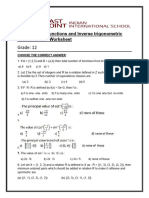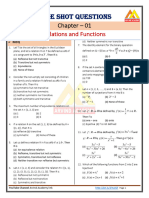0 ratings0% found this document useful (0 votes)
72 viewsTest 1 Xii
1. The document provides a series of math problems involving trigonometric functions, relations, and other concepts.
2. It contains multiple choice and short answer questions ranging from 1 to 4 marks testing a variety of skills.
3. The problems cover topics like evaluating trigonometric functions, determining properties of relations, finding the number of possible relations between sets, and showing relations are equivalence relations.
Uploaded by
Ashis SorenCopyright
© © All Rights Reserved
Available Formats
Download as PDF, TXT or read online on Scribd
0 ratings0% found this document useful (0 votes)
72 viewsTest 1 Xii
1. The document provides a series of math problems involving trigonometric functions, relations, and other concepts.
2. It contains multiple choice and short answer questions ranging from 1 to 4 marks testing a variety of skills.
3. The problems cover topics like evaluating trigonometric functions, determining properties of relations, finding the number of possible relations between sets, and showing relations are equivalence relations.
Uploaded by
Ashis SorenCopyright
© © All Rights Reserved
Available Formats
Download as PDF, TXT or read online on Scribd
You are on page 1/ 2
SINE ME UP
Time Allowed: 1 hours CLASS: XII Maximum Marks: 30
SECTION-A (1 MARK QUESTION)
1. Let f : R → R be defined by
Then find f(– 1) + f(2) + f(4).
2. Let A = {1, 2, 3} and consider the relation R = {1, 1), (2, 2), (3, 3), (1, 2), (2, 3),
(1,3)}.
Then R is,
(a) reflexive but not symmetric (b) reflexive but not transitive
(c) symmetric and transitive (d) neither symmetric, nor transitive
3. If sin–1x + sin–1y = π/2, then calculate the value of cos–1x + cos–1y.
4. Calculate the value of sin[π/3 – sin-1(-½)]
5. Find the principal values of:
SECTION-B (2 MARK QUESTION)
6. Let f : R → R be defined as f(x) = 𝑥 4 . Choose the correct answer with
justification.
(A) f is one-one onto (B) f is many-one onto.
(C) f is one-one but not onto (D) f is neither one-one nor
onto
7. Show that the relation R in the set {1, 2, 3} given by R = {(1, 1), (2, 2), (3, 3), (1,
2), (2, 3)} is reflexive but neither symmetric nor transitive.
OR
Give an example of a relation which is transitive but neither reflexive nor
symmetric.
1
8. If sin (sin-1 5 + cos-1x) = 1, then find the value of x.
9. Write the following functions in the simplest form:
SECTION-C (3 MARK QUESTION)
10. Let f : R → R be defined by f (x) = x + |x|. Show that f is neither one-one nor
onto.
11. Prove that
12. Let A = R – {3} and B = R – {1}. Consider the function f : A → B defined by f(x)
𝑥−2
=𝑥−3. Is f one-one and onto? Justify your answer.
SECTION-D (4 MARK QUESTION)
13. Sherlin and Danju are playing Ludo at
home during Covid-19. While rolling the
dice, Sherlin’s sister Raji observed and
noted the possible outcomes of the throw
every time belongs to set {1,2,3,4,5,6}. Let
A be the set of players while B be the set of
all possible outcomes.
A = {S, D}, B = {1,2,3,4,5,6}
1. Let 𝑅 ∶ 𝐵 → 𝐵 be defined by R = {(𝑥, 𝑦): 𝑦 𝑖𝑠 𝑑𝑖𝑣𝑖𝑠𝑖𝑏𝑙𝑒 𝑏𝑦 𝑥 } is
a. Reflexive and transitive but not symmetric
b. Reflexive and symmetric and not transitive
c. Not reflexive but symmetric and transitive
d. Equivalence
2. Let R be a relation on B defined by R = {(1,2), (2,2), (1,3), (3,4), (3,1), (4,3),
(5,5)}. Then R is
a. Symmetric b. Reflexive
c. Transitive d. None of these three
3. Raji wants to know the number of relations possible from A to B. How many
numbers of relations are possible?
a. 62 b. 26 c. 6! d. 212
4. Let 𝑅: 𝐵 → 𝐵 be defined by R={(1,1),(1,2), (2,2), (3,3), (4,4), (5,5),(6,6)}, then R is
a. Symmetric b. Reflexive and Transitive
c. Transitive and symmetric d. Equivalence
14. Show that the relation R in the set A = {x ∈ Z : 0 ≤ x ≤ 12}, given by R = {(a, b) :
|a– b| is a multiple of 4} is an equivalence relation.
OR
Let L be the set of all lines in XY plane and R be the relation in L defined as R
= {(L1 , L2 ) : L1 is parallel to L2 }. Show that R is an equivalence relation. Find
the set of all lines related to the line y = 2x + 4.
You might also like
- PM Shri KV Gachibowli Maths Class XII Chapter Wise Practice Papers Answers100% (1)PM Shri KV Gachibowli Maths Class XII Chapter Wise Practice Papers Answers102 pages
- The Mechanicals Play Within A Play Edited Script100% (1)The Mechanicals Play Within A Play Edited Script2 pages
- Xii Maths Excellence Series, Ziet, BBSRNo ratings yetXii Maths Excellence Series, Ziet, BBSR201 pages
- Xii Maths Excellence Series, Ziet, BBSRNo ratings yetXii Maths Excellence Series, Ziet, BBSR292 pages
- gr-12 Relations functions and inv trig funs_WorksheetNo ratings yetgr-12 Relations functions and inv trig funs_Worksheet3 pages
- Hsslive-xii-maths-qb-01. RELATIONS AND FUNCTIONSNo ratings yetHsslive-xii-maths-qb-01. RELATIONS AND FUNCTIONS4 pages
- 12_Relations_and_functions_assignment_Faips_2025-26[1]No ratings yet12_Relations_and_functions_assignment_Faips_2025-26[1]3 pages
- 2nd pu mathematics MCQs passing packageNo ratings yet2nd pu mathematics MCQs passing package19 pages
- Class-Xii Maths - Term-1 - Support Materials & MCQ Questions-FinalNo ratings yetClass-Xii Maths - Term-1 - Support Materials & MCQ Questions-Final75 pages
- XII Maths important concept and questionNo ratings yetXII Maths important concept and question73 pages
- Class-Xii Centum Mathematics 05-10-2024 QP Wt-1No ratings yetClass-Xii Centum Mathematics 05-10-2024 QP Wt-14 pages
- MCQ XII (Maths) CH 1-6 2022-23 by KVS ChandigarhNo ratings yetMCQ XII (Maths) CH 1-6 2022-23 by KVS Chandigarh19 pages
- Nagarkurnool - XII MATHEMATICS (Average & High Achievers) (5)No ratings yetNagarkurnool - XII MATHEMATICS (Average & High Achievers) (5)225 pages
- Maths Class Xii Chapter 01 Relations and Functions Practice Paper 01 Answers100% (1)Maths Class Xii Chapter 01 Relations and Functions Practice Paper 01 Answers6 pages
- Maths Class Xii Chapter 01 Relations and Functions Practice Paper 01 2024 AnswersNo ratings yetMaths Class Xii Chapter 01 Relations and Functions Practice Paper 01 2024 Answers7 pages
- Assignment - Chapter-1 - Relations and FunctionsNo ratings yetAssignment - Chapter-1 - Relations and Functions5 pages
- Mathematics MCQ Question Bank Class Xii - 2021 - 22No ratings yetMathematics MCQ Question Bank Class Xii - 2021 - 2287 pages
- 1734551132351c58fafb5027979bda042250c076f72c7No ratings yet1734551132351c58fafb5027979bda042250c076f72c773 pages
- Class 12_KST STUDY POINT_Question Bank_MathsNo ratings yetClass 12_KST STUDY POINT_Question Bank_Maths230 pages
- BS en 13230-4-2016+a1-2020 - (2023-05-31 - 08-27-28 PM)No ratings yetBS en 13230-4-2016+a1-2020 - (2023-05-31 - 08-27-28 PM)24 pages
- Whole Unit 2 - Crude Oil and Refining Product TestingNo ratings yetWhole Unit 2 - Crude Oil and Refining Product Testing113 pages
- Sistema de Riego Automático Con ArduinoNo ratings yetSistema de Riego Automático Con Arduino12 pages
- What Is An Emotion A Debate Adolphs and Lisa F Barret 2020No ratings yetWhat Is An Emotion A Debate Adolphs and Lisa F Barret 202010 pages
- Test Frequency and Acceptance Criteria: Subgrade/Shoulder/Median75% (4)Test Frequency and Acceptance Criteria: Subgrade/Shoulder/Median6 pages
- 2024_02_20_LIM LFSC Practical Task 1 Grade 12 QP ENG FinalNo ratings yet2024_02_20_LIM LFSC Practical Task 1 Grade 12 QP ENG Final6 pages
- Download Complete Designing with the Mind in Mind Simple Guide to Understanding User Interface Design Guidelines 2nd Edition Johnson PDF for All ChaptersNo ratings yetDownload Complete Designing with the Mind in Mind Simple Guide to Understanding User Interface Design Guidelines 2nd Edition Johnson PDF for All Chapters38 pages
- Commerical Invoice: +353 21 4500051 Ap@disc - Ie +353 21 4500051 Ap@disc - IeNo ratings yetCommerical Invoice: +353 21 4500051 Ap@disc - Ie +353 21 4500051 Ap@disc - Ie12 pages
- MDCT: Technical Principles and Future Trends: Mathias ProkopNo ratings yetMDCT: Technical Principles and Future Trends: Mathias Prokop8 pages
- Immune System Song - Ben Kany and John BarbackNo ratings yetImmune System Song - Ben Kany and John Barback3 pages
- 2015 Flowserve Educational Services Course CatalogNo ratings yet2015 Flowserve Educational Services Course Catalog28 pages

























































































